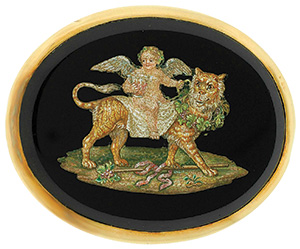|
Legacy
Portrait in Time
Victorian micromosaic jewelry offers timeless works of wearable art.
By Phyllis Schiller

|
| Italian Victorian micromosaic brooch of winged cherub, possibly Dionysus, the god of wine, resting atop a walking lion, centered in oval-shaped plaque of onyx in 14-karat gold bezel setting, circa 1880. Photo courtesy A. Brandt & Son Antique and Estate Jewelry. |
Micromosaic jewelry was a must-have purchase for Victorian tourists on their “Grand Tours” of Europe during the nineteenth century. Most of these portable souvenirs were made in Italy by enterprising artisans whose designs showcased famous architectural sights, religious themes and mythological figures, as well as scarab beetles and other Egyptian Revival motifs. One of the leading names associated with the latter was Fortunato Pio Castellani (1794–1865), whose jewelry is still highly prized today.
Meticulously handcrafted, these micromosaic designs set into jewelry were created from thousands of tiny glass “bricks,” called tesserae, in a wide variety of colors. The different hues were used in much the same manner as a brush stroke on canvas to add depth and detail. “There were all levels of quality available,” says Lisa M. Stockhammer-Mial, president of online retailer The Three Graces. As the micromosaics became more popular, she points out, “the Italians put the micro-mosaic designs in a gold rim as a temporary frame and sold them to French and British jewelers, who set the micromosaics in jewelry. You do see examples from some of the top makers in England, including John Brogden, who made amazing jewelry.”
Like most antique jewelry genres, where a particular style can be the flavor of the moment for a while and then slip out of the spotlight, micromosaic jewelry has seen its ups and downs. “But it has managed to maintain a certain popularity, particularly the more unusual examples, which are difficult to find because they take so much workmanship,” says Stockhammer-Mial.
According to Judith Anderson, Bijoux Extraordinaire and the Jewelry Experts, Manchester, New Hampshire, her customers are “mostly collectors. I generally do not see average buyers purchasing the fine-quality micro-mosaics.” They might be interested in, she says, the Pietra Dura jewelry, a type of mosaic that was also produced for the tourist trade. “It’s a hard-stone inlay, which is not as rare nor as costly as fine micromosaics.” Pietra Dura jewelry, points out Stockhammer-Mial, which has larger pieces of stone that are fit together, can be beautiful, but “I’ve not had as many people eager to buy it.”
Collectors tend to focus on specific subject matter, be it architectural motifs, flowers, insects, etc. “Dogs and hunting themes are pretty popular among collectors, but they don’t show up as much as Roman ruins or Pliny’s Doves,” says Anderson, naming two of the more common micromosaics created for tourists. “Egyptian themes are always popular.”
Jeff Russak, Lawrence Jeffrey Estate Jewelers, Litchfield, Connecticut, cites “dogs, insects, horses and any of the finer early scenes with the smallest tesserae that look like paintings” as subjects that are most in demand.
It is not just the subject of the micromosaic, but the type of jewelry that can make one piece more sought after than another. “People are most interested in necklaces or earrings and bracelets,” says Stockhammer-Mial. Although brooches are generally more readily available, unless the subject matter or workmanship is of a finer quality, they are not as popular.
Whatever the type of jewelry or subject matter, it is the workmanship that is the first criteria of value. Generally, says Stockhammer-Mial, the size of the tesserae is a deciding factor. “The earlier pieces,” points out Russak, “have much finer, smaller tesserae. This greater number of tiles per square inch results in significantly better detail and a wider range and subtlety of color.” The lack of fine workmanship, says Anderson, is one way to judge a reproduction. Telltale signs include “gaps or uneven placement of tesserae.”
Along with the number of tesserae, their condition is also critical to value. If the subject matter is rare, says Stockhammer-Mial, a collector might not mind if a few of the tiny tiles are missing, “but if it’s a more common subject, then it can affect price.”
“All things being equal — condition, subject matter, fineness of the tesserae — brooches are the least expensive,” says Stockhammer-Mial. “Prices go up with earrings, necklaces and the complexity of the setting, as with any jewelry.”
“Micromosaic jewelry is still holding its value…it is not fluctuating that much,” says Annette Brandt, A. Brandt & Son Antique and Estate Jewelry, Narberth, Pennsylvania. “Good examples are out there, but they’re pricey. The rarer pieces, like the Egyptian Revival, are very collectible and will go for a lot of money. You could probably buy a simple dog pin for $1,500 and then prices go up from there, depending how desirable a piece is to a serious collector.”
According to Russak, “the better micromosaic jewelry does not come up very often. Pieces can range from $2,500 to $25,000.” Anderson agrees that finer-quality items, especially demi-parures and full parures, “are rare in general and would command a very high price with collectors.”
Sums up Brandt, “I love micromosaic jewelry. Like any kind of jewelry, sometimes it’s more in fashion than other times, but I think there is always a customer for it. But the average antique buyers need to be educated about it. Once they understand the history and all the work that went into the jewelry, buyers can become fascinated and, in turn, become collectors.” Article from the Rapaport Magazine - November 2013. To subscribe click here.
|
|